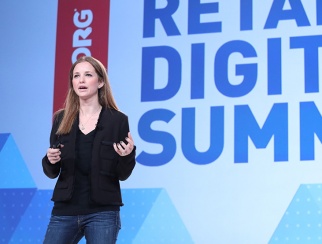A couple of years ago, Mitch Joel took a transformative “trip” to the Amazon rainforest. He was at a Google Zeitgeist event, trying out a Google Cardboard virtual reality headset, and a voice in his ears guided him through his surroundings. That voice led him to notice an insect, and he later discovered that the leader of the class could tell how long it took him to find the bug, how long he paid attention to it and other behavioral data, all based on the way he had moved. And in that moment, he understood: virtual reality could take people where they’ve never been before, in a variety of ways.
See more insights from Retail’s Digital Summit: Check out the event recap.
“We need to start with the understanding that virtual reality and augmented reality is not a screen,” said Joel, addressing the crowd during Retail’s Digital Summit in Dallas last week. “It’s an experience. It’s an environment.”
Joel, president of global digital agency Mirum, was joined by Johnna Marcus, senior director of Sephora’s Innovation Lab, and Sophie Miller from the business development team for Google’s Tango platform, for “Digital Retail’s Fast Track: Virtually There with AR/VR.”
Joel offered a brief definition of terms on the “reality spectrum,” including the real environment, augmented reality, augmented virtuality and the virtual environment. Augmented reality is the ability to see the world as it already is, with information on top of it. Virtual reality, however, is completely immersive.
Why should retailers care about AR/VR right now?
“You have a chance to be first,” Joel said. “There’s definitely a first-mover advantage here.” Augmented and virtual reality move a lever with customer experience like never before and also allow for experimentation.
“Just doing this stuff gets a brand a lot of attention,” he said. “It’s a cheap and effective way to get into the news.” Augmented and virtual reality also are increasingly used for training exercises, reducing costs and creating more engaging education.

Google’s Sophie Miller
Next steps for AV/VR implementation
Miller, meanwhile, spoke of smartphones enabled by Google’s Tango platform, allowing “augmented reality in the palm of your hand.”
She shared a couple of examples. First, there was a video on the Wayfair experience with Tango, getting to the core of visualization, or being able to envision what the product would look like in the consumer’s physical space. Second, an interactive offering from Fiat allows the user to choose features, demonstrating accessibility of inventory, customization and efficiency of the in-store space. To move ahead, Miller had recommendations for retailers:
- Find a key category, a specific place where visualization will enhance the customer experience as well as the relationship with the customer.
- Put together a 3D asset strategy. “Getting the 3D version of that bag, the shirt, the car, whatever it is, is a gating function. Once that’s open, a whole lot of things are possible, in both AR and VR, because it lives in both.”
- Figure out who the new tech ambassadors will be, those who can help show the customer what’s possible with the experience. That can be top customers, members of the sales team or others.

Sephora’s Johnna Marcus
Sephora uses AR to meet needs, inspire customers
Marcus spoke about ensuring that there’s a good business case for anything being developed. With Sephora’s “Teach, Inspire, Play” concept, there have been plenty. She shared several of the company’s efforts to put a beauty expert in consumers’ pockets:
- An augmented reality Pocket Contour experience allows users to learn the techniques of contouring specifically for their face shape, as well as experiment with the help of arrows and dots.
- A mobile app feature allows users to scan various items inside stores for additional AR content. That then rolled into the Play! by Sephora subscription service, with users able to glean AR content from the accompanying brochures.
- Sephora Virtual Artist allows users to try more than 3,000 shades of lipstick and roughly 100 types of false eyelashes through live video rather than an uploaded photo. Sephora has found users might experiment with 50 different lipsticks during a session — something they’d never do in a store. So far, shoppers have tried more than 75 million lip shades. “Long story short,” Marcus said, “people are loving it.”
Joel admitted that despite these examples, such technologies are not necessarily “ready for primetime,” but said retailers should still be paying attention. AR and VR are the “next and probably only platform that we will move to from what I call this one dimension of a screen,” he said.
Video of Digital Retail's Fast Track: Virtually There with AR/VR